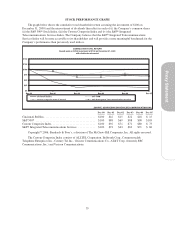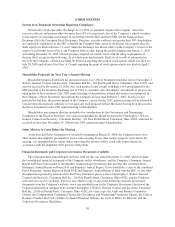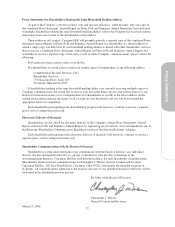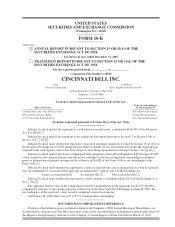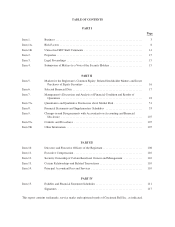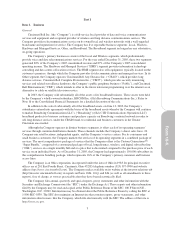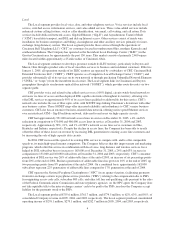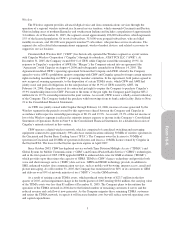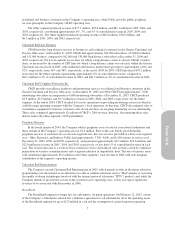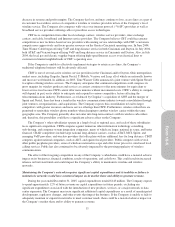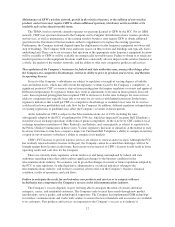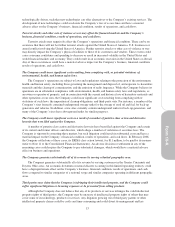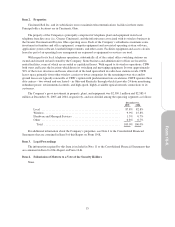Cincinnati Bell 2005 Annual Report Download - page 55
Download and view the complete annual report
Please find page 55 of the 2005 Cincinnati Bell annual report below. You can navigate through the pages in the report by either clicking on the pages listed below, or by using the keyword search tool below to find specific information within the annual report.
Wireless
The Wireless segment provides advanced digital voice and data communications services through the
operation of a regional wireless network in a licensed service territory, which surrounds Cincinnati and Dayton,
Ohio including areas of northern Kentucky and southeastern Indiana and includes a population of approximately
3.4 million. As of December 31, 2005, the segment served approximately 496,000 subscribers, which represents
15% of the licensed population. Of its total subscribers, 315,000 were postpaid subscribers, who are billed
monthly in arrears, and 181,000 were prepaid i-wirelessSM subscribers, who purchase service in advance. The
segment also sells related telecommunications equipment, wireless handset devices, and related accessories to
support its service business.
Cincinnati Bell Wireless LLC (“CBW”) has historically operated the Wireless segment as a joint venture
with Cingular Wireless Corporation (“Cingular”) through its subsidiary, AT&T PCS LLC (“AWE”). At
December 31, 2005, the Company owned 80.1% of CBW while Cingular owned the remaining 19.9%. In
response to Cingular’s acquisition of AWE (the “Merger”), the Company entered into an agreement (the
“Agreement”) with Cingular on August 4, 2004 and subsequently amended it on February 14, 2005. The
Agreement modified CBW’s operating agreement between the Company and AWE, whereby the Company
agreed to waive AWE’s prohibition against competing with CBW and Cingular agreed to forego certain minority
rights including membership on CBW’s governing member committee. In the Agreement, both parties agreed to
new reciprocal roaming agreements, to the disposition of certain TDMA assets, which CBW and AWE had
jointly used, and put/call obligations for the sale/purchase of the 19.9% of CBW owned by AWE. On
February 14, 2006, Cingular exercised its contractual put right to require the Company to purchase Cingular’s
19.9% membership interest in CBW. Pursuant to the terms of the put right, the Company paid Cingular $83.2
million for its 19.9% ownership interest in the joint venture. As a result, CBW is now a wholly-owned subsidiary
of the Company. The Company funded the purchase with borrowings from its bank credit facility. Refer to Note
21 to the Consolidated Financial Statements.
As CBW was jointly owned with Cingular through February 14, 2006, income or losses generated by the
Wireless segment in the periods covered by this report were shared between the Company and Cingular in
accordance with respective ownership percentages of 80.1% and 19.9%. As a result, 19.9% of the net income or
loss of the Wireless segment is reflected as minority interest expense or income in the Company’s Consolidated
Statements of Operations. Refer to Note 9 to the Consolidated Financial Statements for a detailed discussion of
Cingular’s minority interest in this venture.
CBW operates a digital wireless network, which is comprised of centralized switching and messaging
equipment connected to approximately 390 radio base station locations utilizing 30 MHz of wireless spectrum in
the Cincinnati and Dayton Basic Trading Areas (“BTA”). The Company owns the licenses to 30 MHz of
spectrum in Cincinnati and 20 MHz of spectrum in Dayton, and leases a 10 MHz license owned by Cingular in
the Dayton BTA. The lease for the Dayton spectrum expires in April 2007.
Since October 2003, CBW has deployed service on both Time Division Multiple Access (“TDMA”) and
Global System for Mobile Communications (“GSM”) and General Packet Radio Service (“GPRS”) technologies,
and in the first quarter of 2005, CBW upgraded GPRS to enhanced data rates for GSM evolution (“EDGE”),
which provides up to three times the capacity of GPRS. TDMA is CBW’s legacy technology and provides both
voice and short message service (“SMS”) data services. GPRS and EDGE technology provide, in addition to
SMS, enhanced wireless data communication services, such as mobile web browsing, internet access, email and
picture messaging. As of December 31, 2005, the Company has transitioned over 80% of its customers to GSM
and delivers over 90% of network minutes of use (“MOU’s”) via the GSM network.
As a result of retiring certain TDMA assets, which produced write-downs of $23.7 million in the first
quarter of 2005, and an impairment charge in the fourth quarter of 2005 totaling $18.6 million, the carrying value
of the TDMA assets was less than $1 million at December 31, 2005. The Company plans to discontinue the
operation of the TDMA network in 2006 due to the limited number of remaining customers it serves and the
reduced revenue and cash flow it now generates. As the Company migrates these remaining TDMA customers
and retires the TDMA network, it expects it will increase handset costs but will reduce network operating costs
and capital expenditures.
5




